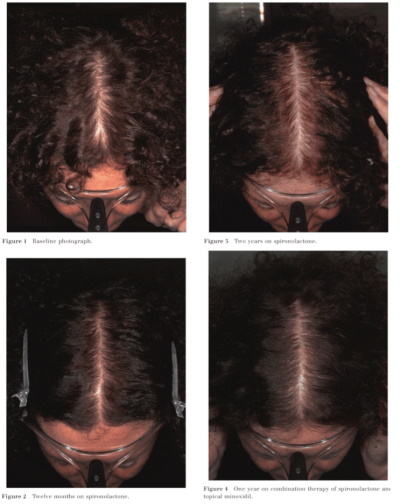Spironolactone is a powerful weapon against female hair loss. It’s so potent, some guys are even starting to jump on the bandwagon!
In this post, I’ll cover everything you need to know about Spironolactone, so you can decide if it’s a treatment worth further review. Let’s dive right in.
What is Spironolactone?
It’s got a long and not very memorable name. Also known by the brand-name Aldactone, it’s a drug that’s been around since the 50s.
It’s effectively a water pill that prevents the body from absorbing too much salt. It also helps regulate potassium levels.
Spironolactone Uses
Known for its incredible utility, Spironolactone has been found to effectively treat an astounding number of conditions, including but not limited to:
Acne
It’s sometimes recommended to women with severe or hard-to-treat acne. No long-term studies have tested its long-term safety or efficacy as an acne medication, but the early research has shown promising results.
Edema
Edema is swelling that occurs as a result of a fluid buildup in the body. In severe cases it can lead to heart and renal failure. A 2010 study tested Spironolactone as an edema treatment. Researchers found that it worked well, in small does, in treating the condition.
High Blood Pressure
While not a first-line blood pressure medication, Spironolactone is sometimes prescribed to treat patients with uncontrolled hypertension.
Polycystic Ovary Syndrome
Spironolactone is known to reduce androgens, male sex hormones linked to facial hair growth. Women with Polycystic Ovary Syndrome have higher numbers of androgens and often experience multiple benefits with the drug. It can help treat acne, hair loss, and Hirsutism (excessive body hair growth).
Hirsutism
The treatment is also sometimes prescribed in other cases of hirsutism.
Although other, more proven treatment methods are available, Spironolactone is prescribed off-label for Hirsutism on a semi-regular basis.
Heart Failure
In 1999, researchers tested Spironolactone on 1,663 patients with heart failure. 822 received a daily dose spironolactone. The control (placebo) group consisted of 922 patients.
By the study’s conclusion, researchers found Spironolactone reduced the risk of hospitalization by 35%. It also reduced the risk of death by 30%.
And More
It’s a high utility drug that’s been prescribed for a wide range of affiliations and conditions.
Spironolactone for Hair Loss
Spironolactone has been shown to reduce the levels of DHT, AKA the baldness hormone. It’s the hormone linked to pattern hair loss in men and women.
There haven’t been a large number of studies on spironolactone as a hair loss treatment. However, in 2018, an Australian dermatologist tested a new pattern hair loss treatment combination: Spironolactone with minoxidil.
Patients took 25 milligrams of Spironolactone in conjunction .25 mg of oral minoxidil. Yes, Rogaine effectively comes in pill form too — and it’s quite effective at treating hair loss.
When the study ended, Sinclair reached the following conclusions
- Nearly 3 times less shedding reported in patients after six months compared to their baseline results.
- Side effects were mild.
- No patients developed hyperkalemia, high potassium levels, a commonly reported side effect.
- Further, placebo-controlled studies are in order.

One woman’s results from the study. After two years — see the picture on the top right — the medication’s effectiveness was found to plateau.
Regularly Prescribed Off Label to Women
It’s not FDA approved to treat hair loss in men or women.
The treatment is primarily reserved for women at this point.
In an earlier study, spironolactone also demonstrated efficacy as a treatment for female hair loss. 19 patients took spironolactone for a total of 20 months. Physicians reviewed each patient’s progress throughout and found the following:
- Increased thickness in 6 out of 19 patients
- Mild improvements in 8 patients
- No change in the remaining 5
Usually Prescribed at High Doses for Hair Loss
According to Hair Restoration of the South and previous research, spironolactone needs to be prescribed at 150 to 200 milligrams daily to treat female hair loss. They recommend using the treatment for at least 6 months. Comparatively, the drug is only prescribed at 25-100 milligrams daily for acne.
Spironolactone Creams Also Available
Again, while the research is limited, a number of spironolactone creams are available to treat hair loss. These creams have been well-tolerated by patients.
Spironolactone Side Effects
Since Spironolactone is a diuretic, it can increase the body’s potassium levels. The kidneys can usually adjust to these changes without medical interventions.
But if you have a history of kidney disease, you’ll want to proceed with extra caution.
Many doctors advise Spironolactone users to have their kidneys checked periodically. Other possible side effects of Spironolactone include:
- Leg cramps
- Loss of interest in sex
- Burning sensation in the chest or stomach
- Nipple pain
- Nausea
- Lethargy/Weakness
Be sure to talk to your doctor if you notice any major side effects, including but not limited to:
- Chest pain
- Painful or difficult urination
- Confusion
- Blurred vision
- Seizures
- Swelling of the face, hands or feet.
Spironolactone Alternatives
Finasteride
FDA approved for men only, Finasteride has become increasingly popular among female hair loss sufferers over the last few years. It’s a somewhat controversial option, but early research indicates it’s generally safe and quite effective for women.
Related: 12 Things All Women Should Know if They’re Considering Finasteride for Hair Loss.
Birth Control Pills
Certain oral contraceptives such as Yaz and Yasmin work well for many female hair loss patients. Potential side effects include acne, blood clots, and sore breasts, to name a few.
Estrogen/Progesterone
Also known as hormone replacement therapy, a variety of estrogen and progesterone treatments are prescribed for female hair loss. Both oral and topicals are available. A 2006 Greek Study in which participants used an estrogen cream found that the treatment was effective for 65% of the patients.
Adjunct Therapies
Minoxidil
The #1 OTC treatment for female hair loss. It works for about 60% of women. Side effects are rare and it’s an easy treatment to add to your regimen. For more info, check out my complete minoxidil guide for women.
Ketoconazole Shampoo
While no shampoo is likely to stop hair loss altogether, the ingredient Ketoconazole may help slow the process to some degree. Popular products like Lipogaine Big 3 Shampoo have been shown to help mitigate hair loss and improve overall hair health.
Laser Therapy
While this is a secondary treatment for men, laser therapy is a very popular and effective option for women. It helps reboot the hair follicles at the cellular level and can easily be combined with other therapies. Before you buy a laser helmet, cap, or comp, be sure to read my in-depth article on laser therapy.
Spironolactone for Hair Loss – Conclusion
If you have any questions or concerns about Spironolactone, or a personal experience to share, I’d love to hear from you in the comment section. As of 2020, it’s one of my top 12 treatments for female hair loss.
Robert Price is a writer, consumer advocate, and hair loss researcher with thousands of hours of experience in the field. His goal is to keep you out of the hair loss rabbit hole, underworld, or whatever you want to call it. He founded Hair Loss Daily, the unbiased hair loss blog, in 2016. You can learn more about Robert in the my story section of this website.
